Diabetes Management: Global Impact, Metabolism and Etiology Analysis
VerifiedAdded on 2022/08/23
|9
|2532
|13
Report
AI Summary
This report provides a comprehensive overview of diabetes, encompassing the global epidemic, energy metabolism, and the pathophysiology of the disease. It begins by examining the prevalence of diabetes worldwide, highlighting the significant impact on various populations, with a focus on Australia. The report delves into the key features defining chronic conditions and the associated direct and indirect costs of diabetes, as well as outlining the goals and strategies for diabetes management. It then explores energy metabolism and glucose homeostasis, detailing the absorption of carbohydrates, the role of glucose in vital organs, and the processes of glycogenolysis and glycogenosis. The report also discusses the structure of proinsulin, the function of glucose transporters and incretins, and the role of counter-regulatory hormones. Finally, the report investigates the pathophysiology and etiology of diabetes, differentiating between type 1 and type 2 diabetes, gestational diabetes, and other forms of the disease, including maturity onset diabetes of the young and neonatal diabetes. The report also explores the role of insulin resistance, metabolic syndrome, and the aetiological classification of diabetes. References from reputable sources are included to support the information presented.
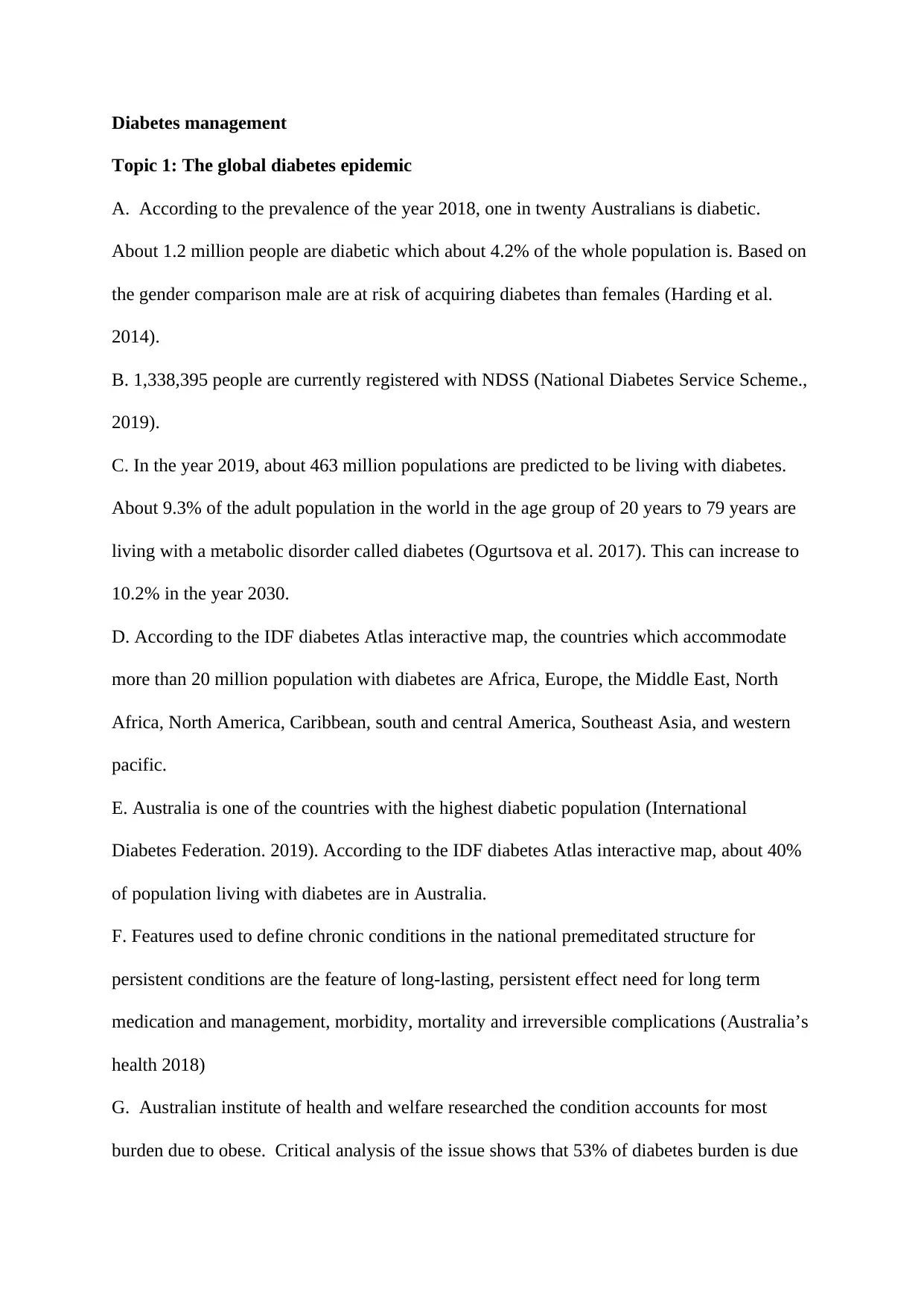
Diabetes management
Topic 1: The global diabetes epidemic
A. According to the prevalence of the year 2018, one in twenty Australians is diabetic.
About 1.2 million people are diabetic which about 4.2% of the whole population is. Based on
the gender comparison male are at risk of acquiring diabetes than females (Harding et al.
2014).
B. 1,338,395 people are currently registered with NDSS (National Diabetes Service Scheme.,
2019).
C. In the year 2019, about 463 million populations are predicted to be living with diabetes.
About 9.3% of the adult population in the world in the age group of 20 years to 79 years are
living with a metabolic disorder called diabetes (Ogurtsova et al. 2017). This can increase to
10.2% in the year 2030.
D. According to the IDF diabetes Atlas interactive map, the countries which accommodate
more than 20 million population with diabetes are Africa, Europe, the Middle East, North
Africa, North America, Caribbean, south and central America, Southeast Asia, and western
pacific.
E. Australia is one of the countries with the highest diabetic population (International
Diabetes Federation. 2019). According to the IDF diabetes Atlas interactive map, about 40%
of population living with diabetes are in Australia.
F. Features used to define chronic conditions in the national premeditated structure for
persistent conditions are the feature of long-lasting, persistent effect need for long term
medication and management, morbidity, mortality and irreversible complications (Australia’s
health 2018)
G. Australian institute of health and welfare researched the condition accounts for most
burden due to obese. Critical analysis of the issue shows that 53% of diabetes burden is due
Topic 1: The global diabetes epidemic
A. According to the prevalence of the year 2018, one in twenty Australians is diabetic.
About 1.2 million people are diabetic which about 4.2% of the whole population is. Based on
the gender comparison male are at risk of acquiring diabetes than females (Harding et al.
2014).
B. 1,338,395 people are currently registered with NDSS (National Diabetes Service Scheme.,
2019).
C. In the year 2019, about 463 million populations are predicted to be living with diabetes.
About 9.3% of the adult population in the world in the age group of 20 years to 79 years are
living with a metabolic disorder called diabetes (Ogurtsova et al. 2017). This can increase to
10.2% in the year 2030.
D. According to the IDF diabetes Atlas interactive map, the countries which accommodate
more than 20 million population with diabetes are Africa, Europe, the Middle East, North
Africa, North America, Caribbean, south and central America, Southeast Asia, and western
pacific.
E. Australia is one of the countries with the highest diabetic population (International
Diabetes Federation. 2019). According to the IDF diabetes Atlas interactive map, about 40%
of population living with diabetes are in Australia.
F. Features used to define chronic conditions in the national premeditated structure for
persistent conditions are the feature of long-lasting, persistent effect need for long term
medication and management, morbidity, mortality and irreversible complications (Australia’s
health 2018)
G. Australian institute of health and welfare researched the condition accounts for most
burden due to obese. Critical analysis of the issue shows that 53% of diabetes burden is due
Paraphrase This Document
Need a fresh take? Get an instant paraphrase of this document with our AI Paraphraser
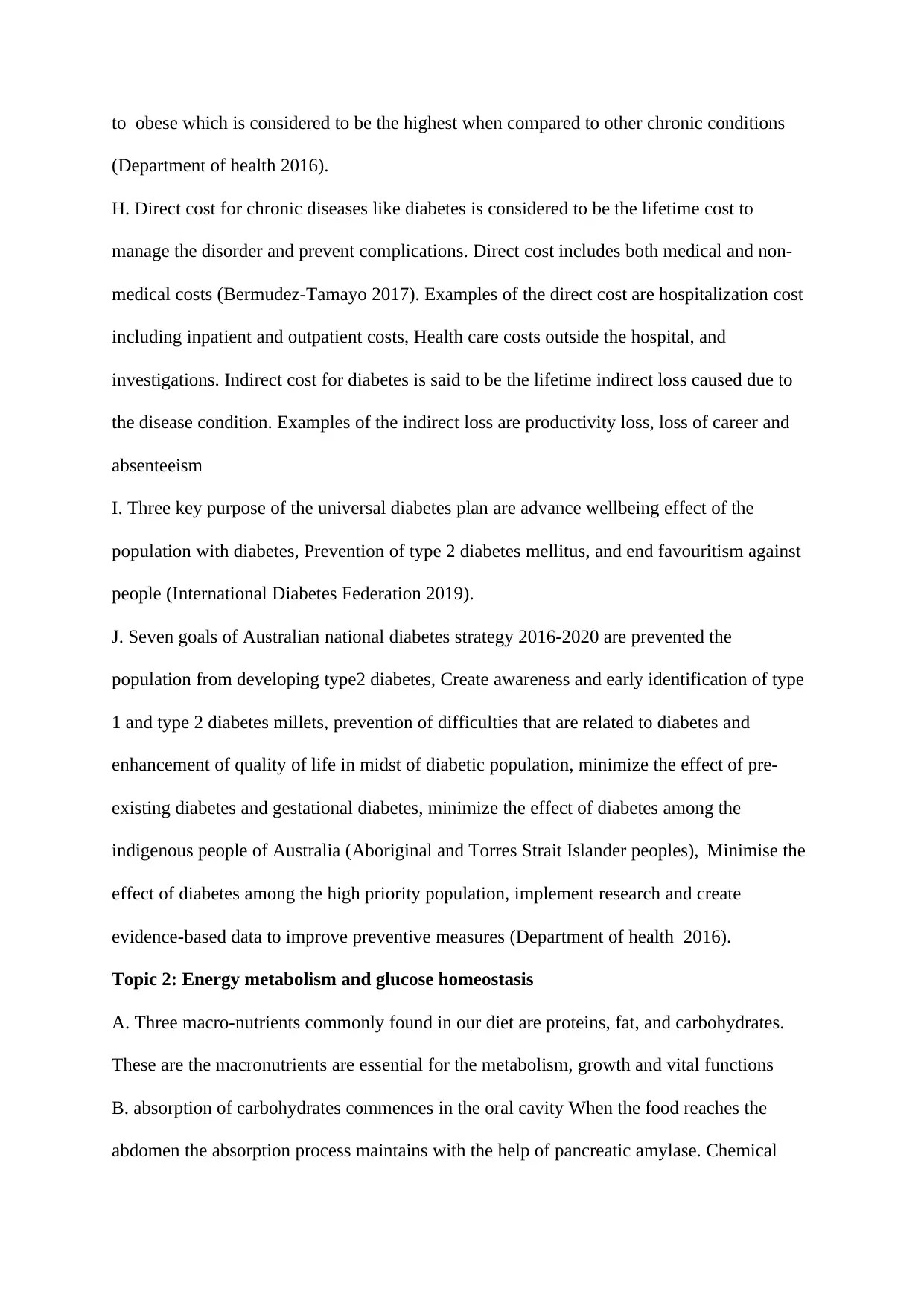
to obese which is considered to be the highest when compared to other chronic conditions
(Department of health 2016).
H. Direct cost for chronic diseases like diabetes is considered to be the lifetime cost to
manage the disorder and prevent complications. Direct cost includes both medical and non-
medical costs (Bermudez-Tamayo 2017). Examples of the direct cost are hospitalization cost
including inpatient and outpatient costs, Health care costs outside the hospital, and
investigations. Indirect cost for diabetes is said to be the lifetime indirect loss caused due to
the disease condition. Examples of the indirect loss are productivity loss, loss of career and
absenteeism
I. Three key purpose of the universal diabetes plan are advance wellbeing effect of the
population with diabetes, Prevention of type 2 diabetes mellitus, and end favouritism against
people (International Diabetes Federation 2019).
J. Seven goals of Australian national diabetes strategy 2016-2020 are prevented the
population from developing type2 diabetes, Create awareness and early identification of type
1 and type 2 diabetes millets, prevention of difficulties that are related to diabetes and
enhancement of quality of life in midst of diabetic population, minimize the effect of pre-
existing diabetes and gestational diabetes, minimize the effect of diabetes among the
indigenous people of Australia (Aboriginal and Torres Strait Islander peoples), Minimise the
effect of diabetes among the high priority population, implement research and create
evidence-based data to improve preventive measures (Department of health 2016).
Topic 2: Energy metabolism and glucose homeostasis
A. Three macro-nutrients commonly found in our diet are proteins, fat, and carbohydrates.
These are the macronutrients are essential for the metabolism, growth and vital functions
B. absorption of carbohydrates commences in the oral cavity When the food reaches the
abdomen the absorption process maintains with the help of pancreatic amylase. Chemical
(Department of health 2016).
H. Direct cost for chronic diseases like diabetes is considered to be the lifetime cost to
manage the disorder and prevent complications. Direct cost includes both medical and non-
medical costs (Bermudez-Tamayo 2017). Examples of the direct cost are hospitalization cost
including inpatient and outpatient costs, Health care costs outside the hospital, and
investigations. Indirect cost for diabetes is said to be the lifetime indirect loss caused due to
the disease condition. Examples of the indirect loss are productivity loss, loss of career and
absenteeism
I. Three key purpose of the universal diabetes plan are advance wellbeing effect of the
population with diabetes, Prevention of type 2 diabetes mellitus, and end favouritism against
people (International Diabetes Federation 2019).
J. Seven goals of Australian national diabetes strategy 2016-2020 are prevented the
population from developing type2 diabetes, Create awareness and early identification of type
1 and type 2 diabetes millets, prevention of difficulties that are related to diabetes and
enhancement of quality of life in midst of diabetic population, minimize the effect of pre-
existing diabetes and gestational diabetes, minimize the effect of diabetes among the
indigenous people of Australia (Aboriginal and Torres Strait Islander peoples), Minimise the
effect of diabetes among the high priority population, implement research and create
evidence-based data to improve preventive measures (Department of health 2016).
Topic 2: Energy metabolism and glucose homeostasis
A. Three macro-nutrients commonly found in our diet are proteins, fat, and carbohydrates.
These are the macronutrients are essential for the metabolism, growth and vital functions
B. absorption of carbohydrates commences in the oral cavity When the food reaches the
abdomen the absorption process maintains with the help of pancreatic amylase. Chemical
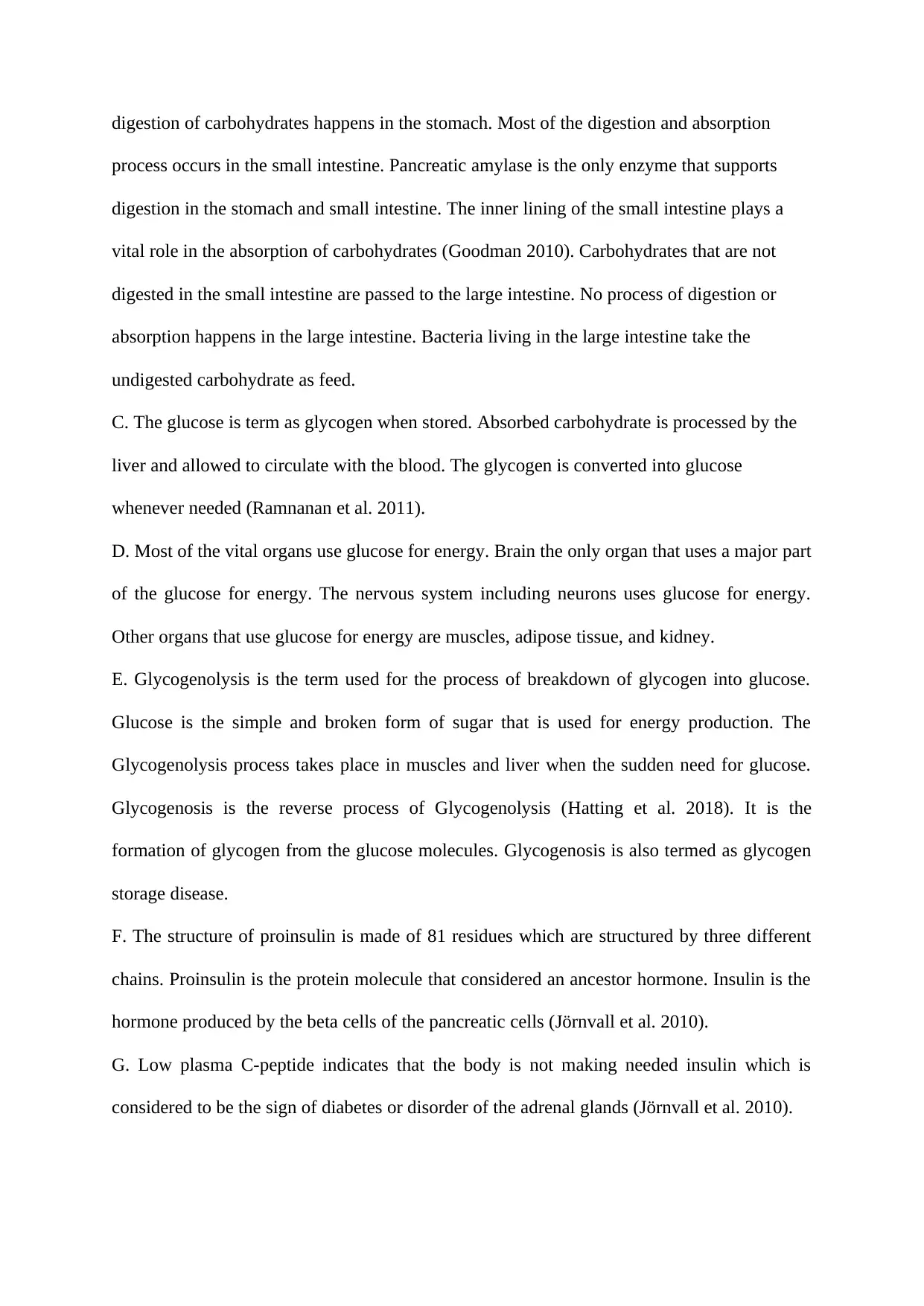
digestion of carbohydrates happens in the stomach. Most of the digestion and absorption
process occurs in the small intestine. Pancreatic amylase is the only enzyme that supports
digestion in the stomach and small intestine. The inner lining of the small intestine plays a
vital role in the absorption of carbohydrates (Goodman 2010). Carbohydrates that are not
digested in the small intestine are passed to the large intestine. No process of digestion or
absorption happens in the large intestine. Bacteria living in the large intestine take the
undigested carbohydrate as feed.
C. The glucose is term as glycogen when stored. Absorbed carbohydrate is processed by the
liver and allowed to circulate with the blood. The glycogen is converted into glucose
whenever needed (Ramnanan et al. 2011).
D. Most of the vital organs use glucose for energy. Brain the only organ that uses a major part
of the glucose for energy. The nervous system including neurons uses glucose for energy.
Other organs that use glucose for energy are muscles, adipose tissue, and kidney.
E. Glycogenolysis is the term used for the process of breakdown of glycogen into glucose.
Glucose is the simple and broken form of sugar that is used for energy production. The
Glycogenolysis process takes place in muscles and liver when the sudden need for glucose.
Glycogenosis is the reverse process of Glycogenolysis (Hatting et al. 2018). It is the
formation of glycogen from the glucose molecules. Glycogenosis is also termed as glycogen
storage disease.
F. The structure of proinsulin is made of 81 residues which are structured by three different
chains. Proinsulin is the protein molecule that considered an ancestor hormone. Insulin is the
hormone produced by the beta cells of the pancreatic cells (Jörnvall et al. 2010).
G. Low plasma C-peptide indicates that the body is not making needed insulin which is
considered to be the sign of diabetes or disorder of the adrenal glands (Jörnvall et al. 2010).
process occurs in the small intestine. Pancreatic amylase is the only enzyme that supports
digestion in the stomach and small intestine. The inner lining of the small intestine plays a
vital role in the absorption of carbohydrates (Goodman 2010). Carbohydrates that are not
digested in the small intestine are passed to the large intestine. No process of digestion or
absorption happens in the large intestine. Bacteria living in the large intestine take the
undigested carbohydrate as feed.
C. The glucose is term as glycogen when stored. Absorbed carbohydrate is processed by the
liver and allowed to circulate with the blood. The glycogen is converted into glucose
whenever needed (Ramnanan et al. 2011).
D. Most of the vital organs use glucose for energy. Brain the only organ that uses a major part
of the glucose for energy. The nervous system including neurons uses glucose for energy.
Other organs that use glucose for energy are muscles, adipose tissue, and kidney.
E. Glycogenolysis is the term used for the process of breakdown of glycogen into glucose.
Glucose is the simple and broken form of sugar that is used for energy production. The
Glycogenolysis process takes place in muscles and liver when the sudden need for glucose.
Glycogenosis is the reverse process of Glycogenolysis (Hatting et al. 2018). It is the
formation of glycogen from the glucose molecules. Glycogenosis is also termed as glycogen
storage disease.
F. The structure of proinsulin is made of 81 residues which are structured by three different
chains. Proinsulin is the protein molecule that considered an ancestor hormone. Insulin is the
hormone produced by the beta cells of the pancreatic cells (Jörnvall et al. 2010).
G. Low plasma C-peptide indicates that the body is not making needed insulin which is
considered to be the sign of diabetes or disorder of the adrenal glands (Jörnvall et al. 2010).
⊘ This is a preview!⊘
Do you want full access?
Subscribe today to unlock all pages.

Trusted by 1+ million students worldwide
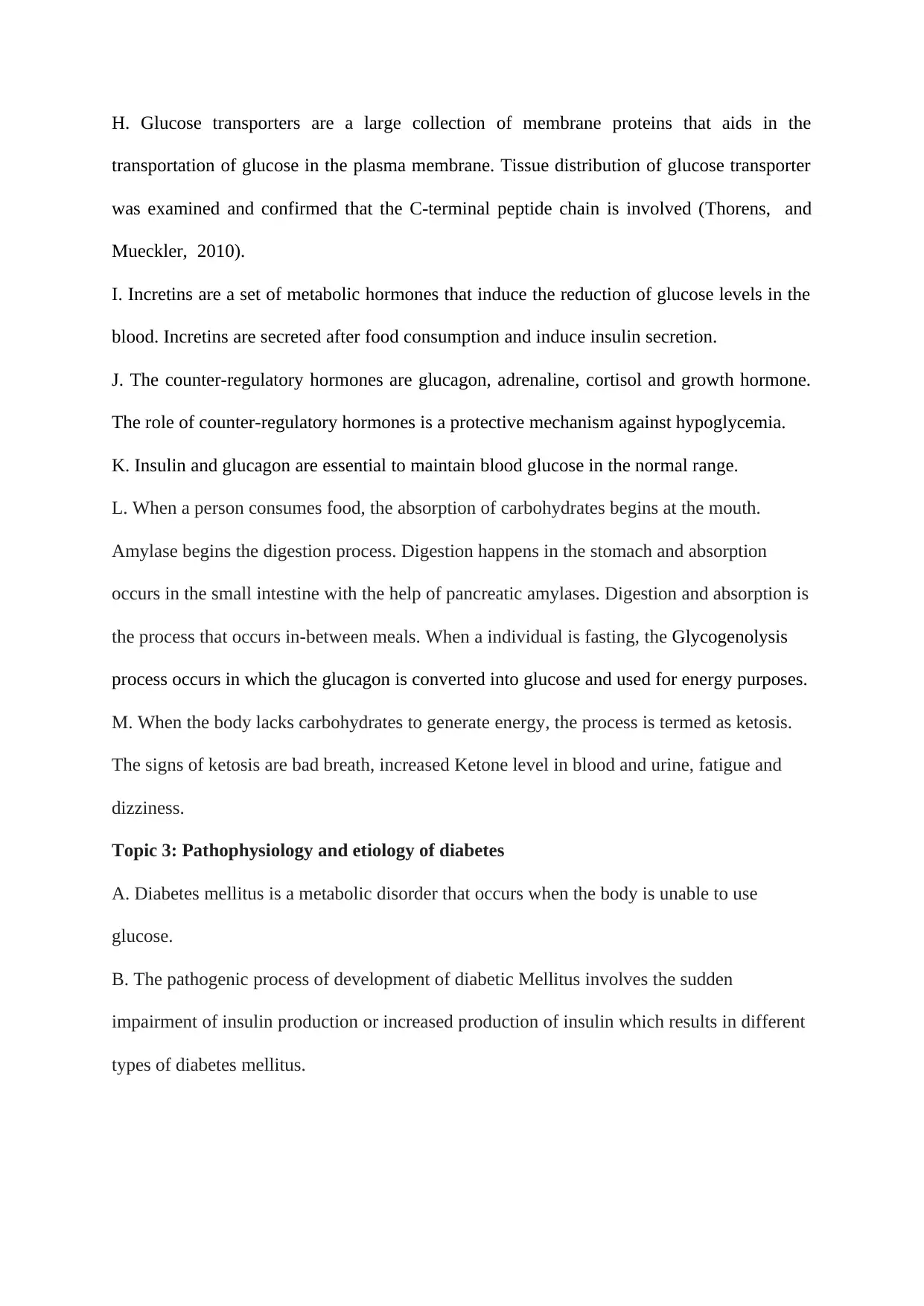
H. Glucose transporters are a large collection of membrane proteins that aids in the
transportation of glucose in the plasma membrane. Tissue distribution of glucose transporter
was examined and confirmed that the C-terminal peptide chain is involved (Thorens, and
Mueckler, 2010).
I. Incretins are a set of metabolic hormones that induce the reduction of glucose levels in the
blood. Incretins are secreted after food consumption and induce insulin secretion.
J. The counter-regulatory hormones are glucagon, adrenaline, cortisol and growth hormone.
The role of counter-regulatory hormones is a protective mechanism against hypoglycemia.
K. Insulin and glucagon are essential to maintain blood glucose in the normal range.
L. When a person consumes food, the absorption of carbohydrates begins at the mouth.
Amylase begins the digestion process. Digestion happens in the stomach and absorption
occurs in the small intestine with the help of pancreatic amylases. Digestion and absorption is
the process that occurs in-between meals. When a individual is fasting, the Glycogenolysis
process occurs in which the glucagon is converted into glucose and used for energy purposes.
M. When the body lacks carbohydrates to generate energy, the process is termed as ketosis.
The signs of ketosis are bad breath, increased Ketone level in blood and urine, fatigue and
dizziness.
Topic 3: Pathophysiology and etiology of diabetes
A. Diabetes mellitus is a metabolic disorder that occurs when the body is unable to use
glucose.
B. The pathogenic process of development of diabetic Mellitus involves the sudden
impairment of insulin production or increased production of insulin which results in different
types of diabetes mellitus.
transportation of glucose in the plasma membrane. Tissue distribution of glucose transporter
was examined and confirmed that the C-terminal peptide chain is involved (Thorens, and
Mueckler, 2010).
I. Incretins are a set of metabolic hormones that induce the reduction of glucose levels in the
blood. Incretins are secreted after food consumption and induce insulin secretion.
J. The counter-regulatory hormones are glucagon, adrenaline, cortisol and growth hormone.
The role of counter-regulatory hormones is a protective mechanism against hypoglycemia.
K. Insulin and glucagon are essential to maintain blood glucose in the normal range.
L. When a person consumes food, the absorption of carbohydrates begins at the mouth.
Amylase begins the digestion process. Digestion happens in the stomach and absorption
occurs in the small intestine with the help of pancreatic amylases. Digestion and absorption is
the process that occurs in-between meals. When a individual is fasting, the Glycogenolysis
process occurs in which the glucagon is converted into glucose and used for energy purposes.
M. When the body lacks carbohydrates to generate energy, the process is termed as ketosis.
The signs of ketosis are bad breath, increased Ketone level in blood and urine, fatigue and
dizziness.
Topic 3: Pathophysiology and etiology of diabetes
A. Diabetes mellitus is a metabolic disorder that occurs when the body is unable to use
glucose.
B. The pathogenic process of development of diabetic Mellitus involves the sudden
impairment of insulin production or increased production of insulin which results in different
types of diabetes mellitus.
Paraphrase This Document
Need a fresh take? Get an instant paraphrase of this document with our AI Paraphraser
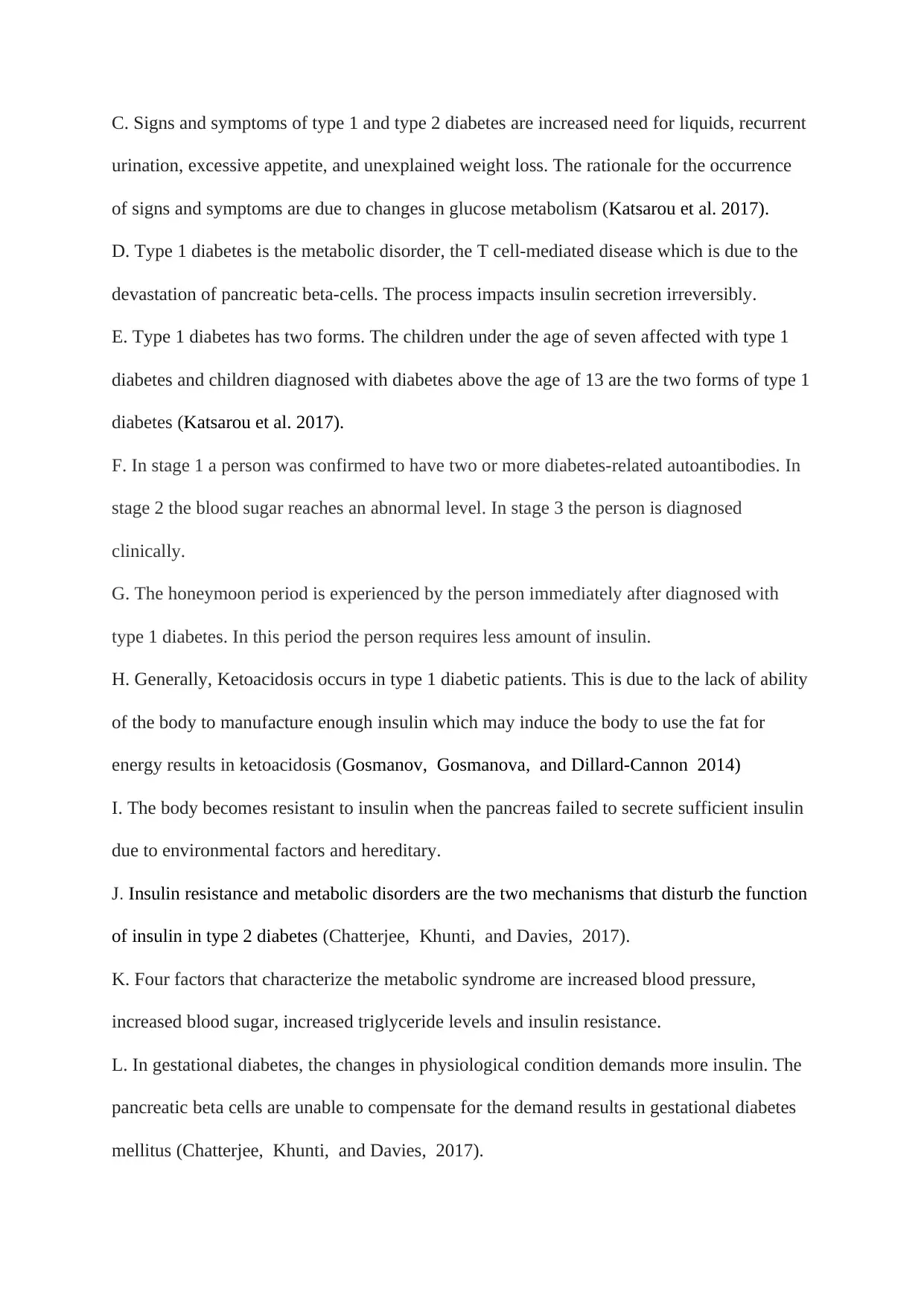
C. Signs and symptoms of type 1 and type 2 diabetes are increased need for liquids, recurrent
urination, excessive appetite, and unexplained weight loss. The rationale for the occurrence
of signs and symptoms are due to changes in glucose metabolism (Katsarou et al. 2017).
D. Type 1 diabetes is the metabolic disorder, the T cell-mediated disease which is due to the
devastation of pancreatic beta-cells. The process impacts insulin secretion irreversibly.
E. Type 1 diabetes has two forms. The children under the age of seven affected with type 1
diabetes and children diagnosed with diabetes above the age of 13 are the two forms of type 1
diabetes (Katsarou et al. 2017).
F. In stage 1 a person was confirmed to have two or more diabetes-related autoantibodies. In
stage 2 the blood sugar reaches an abnormal level. In stage 3 the person is diagnosed
clinically.
G. The honeymoon period is experienced by the person immediately after diagnosed with
type 1 diabetes. In this period the person requires less amount of insulin.
H. Generally, Ketoacidosis occurs in type 1 diabetic patients. This is due to the lack of ability
of the body to manufacture enough insulin which may induce the body to use the fat for
energy results in ketoacidosis (Gosmanov, Gosmanova, and Dillard-Cannon 2014)
I. The body becomes resistant to insulin when the pancreas failed to secrete sufficient insulin
due to environmental factors and hereditary.
J. Insulin resistance and metabolic disorders are the two mechanisms that disturb the function
of insulin in type 2 diabetes (Chatterjee, Khunti, and Davies, 2017).
K. Four factors that characterize the metabolic syndrome are increased blood pressure,
increased blood sugar, increased triglyceride levels and insulin resistance.
L. In gestational diabetes, the changes in physiological condition demands more insulin. The
pancreatic beta cells are unable to compensate for the demand results in gestational diabetes
mellitus (Chatterjee, Khunti, and Davies, 2017).
urination, excessive appetite, and unexplained weight loss. The rationale for the occurrence
of signs and symptoms are due to changes in glucose metabolism (Katsarou et al. 2017).
D. Type 1 diabetes is the metabolic disorder, the T cell-mediated disease which is due to the
devastation of pancreatic beta-cells. The process impacts insulin secretion irreversibly.
E. Type 1 diabetes has two forms. The children under the age of seven affected with type 1
diabetes and children diagnosed with diabetes above the age of 13 are the two forms of type 1
diabetes (Katsarou et al. 2017).
F. In stage 1 a person was confirmed to have two or more diabetes-related autoantibodies. In
stage 2 the blood sugar reaches an abnormal level. In stage 3 the person is diagnosed
clinically.
G. The honeymoon period is experienced by the person immediately after diagnosed with
type 1 diabetes. In this period the person requires less amount of insulin.
H. Generally, Ketoacidosis occurs in type 1 diabetic patients. This is due to the lack of ability
of the body to manufacture enough insulin which may induce the body to use the fat for
energy results in ketoacidosis (Gosmanov, Gosmanova, and Dillard-Cannon 2014)
I. The body becomes resistant to insulin when the pancreas failed to secrete sufficient insulin
due to environmental factors and hereditary.
J. Insulin resistance and metabolic disorders are the two mechanisms that disturb the function
of insulin in type 2 diabetes (Chatterjee, Khunti, and Davies, 2017).
K. Four factors that characterize the metabolic syndrome are increased blood pressure,
increased blood sugar, increased triglyceride levels and insulin resistance.
L. In gestational diabetes, the changes in physiological condition demands more insulin. The
pancreatic beta cells are unable to compensate for the demand results in gestational diabetes
mellitus (Chatterjee, Khunti, and Davies, 2017).
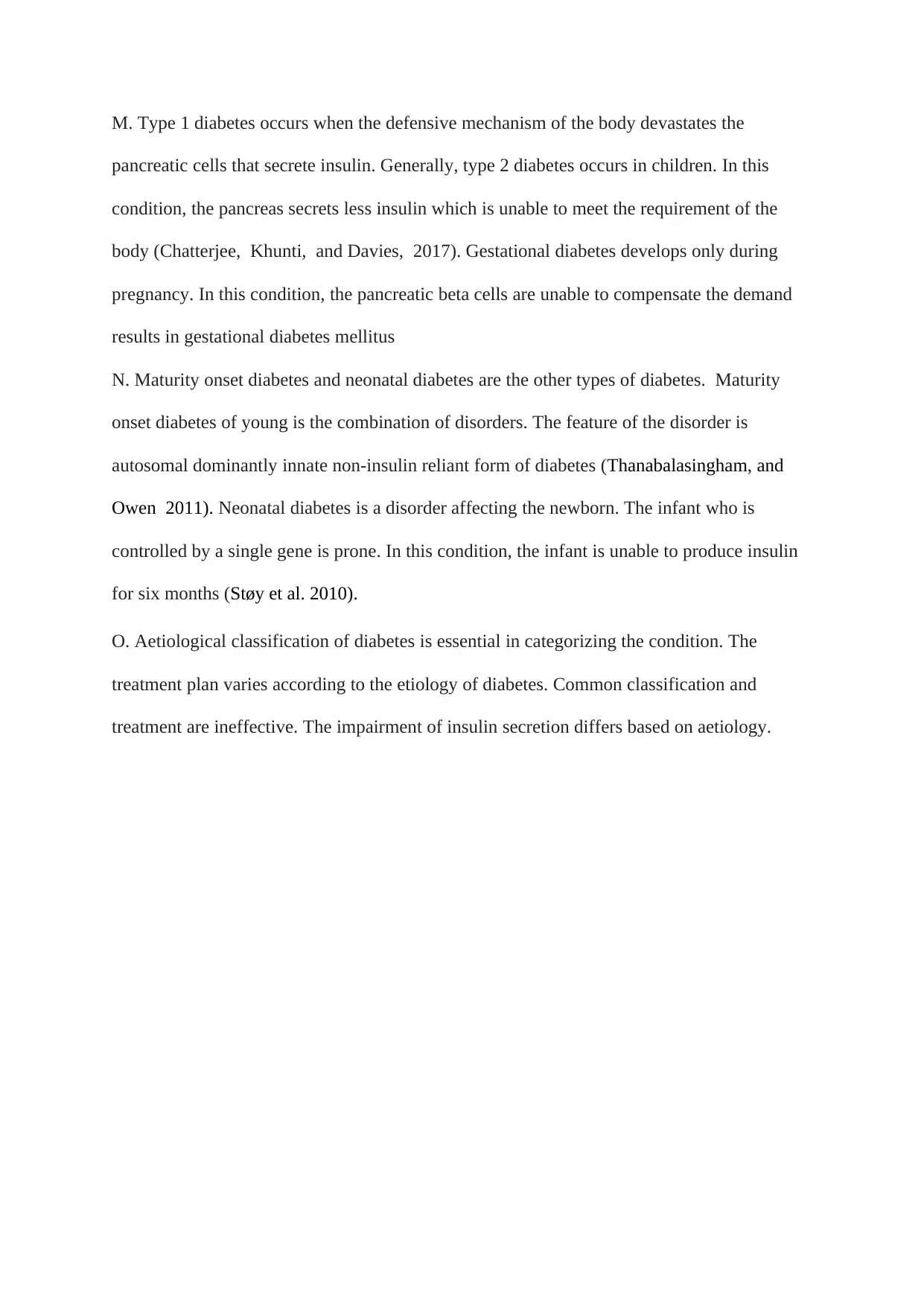
M. Type 1 diabetes occurs when the defensive mechanism of the body devastates the
pancreatic cells that secrete insulin. Generally, type 2 diabetes occurs in children. In this
condition, the pancreas secrets less insulin which is unable to meet the requirement of the
body (Chatterjee, Khunti, and Davies, 2017). Gestational diabetes develops only during
pregnancy. In this condition, the pancreatic beta cells are unable to compensate the demand
results in gestational diabetes mellitus
N. Maturity onset diabetes and neonatal diabetes are the other types of diabetes. Maturity
onset diabetes of young is the combination of disorders. The feature of the disorder is
autosomal dominantly innate non-insulin reliant form of diabetes (Thanabalasingham, and
Owen 2011). Neonatal diabetes is a disorder affecting the newborn. The infant who is
controlled by a single gene is prone. In this condition, the infant is unable to produce insulin
for six months (Støy et al. 2010).
O. Aetiological classification of diabetes is essential in categorizing the condition. The
treatment plan varies according to the etiology of diabetes. Common classification and
treatment are ineffective. The impairment of insulin secretion differs based on aetiology.
pancreatic cells that secrete insulin. Generally, type 2 diabetes occurs in children. In this
condition, the pancreas secrets less insulin which is unable to meet the requirement of the
body (Chatterjee, Khunti, and Davies, 2017). Gestational diabetes develops only during
pregnancy. In this condition, the pancreatic beta cells are unable to compensate the demand
results in gestational diabetes mellitus
N. Maturity onset diabetes and neonatal diabetes are the other types of diabetes. Maturity
onset diabetes of young is the combination of disorders. The feature of the disorder is
autosomal dominantly innate non-insulin reliant form of diabetes (Thanabalasingham, and
Owen 2011). Neonatal diabetes is a disorder affecting the newborn. The infant who is
controlled by a single gene is prone. In this condition, the infant is unable to produce insulin
for six months (Støy et al. 2010).
O. Aetiological classification of diabetes is essential in categorizing the condition. The
treatment plan varies according to the etiology of diabetes. Common classification and
treatment are ineffective. The impairment of insulin secretion differs based on aetiology.
⊘ This is a preview!⊘
Do you want full access?
Subscribe today to unlock all pages.

Trusted by 1+ million students worldwide
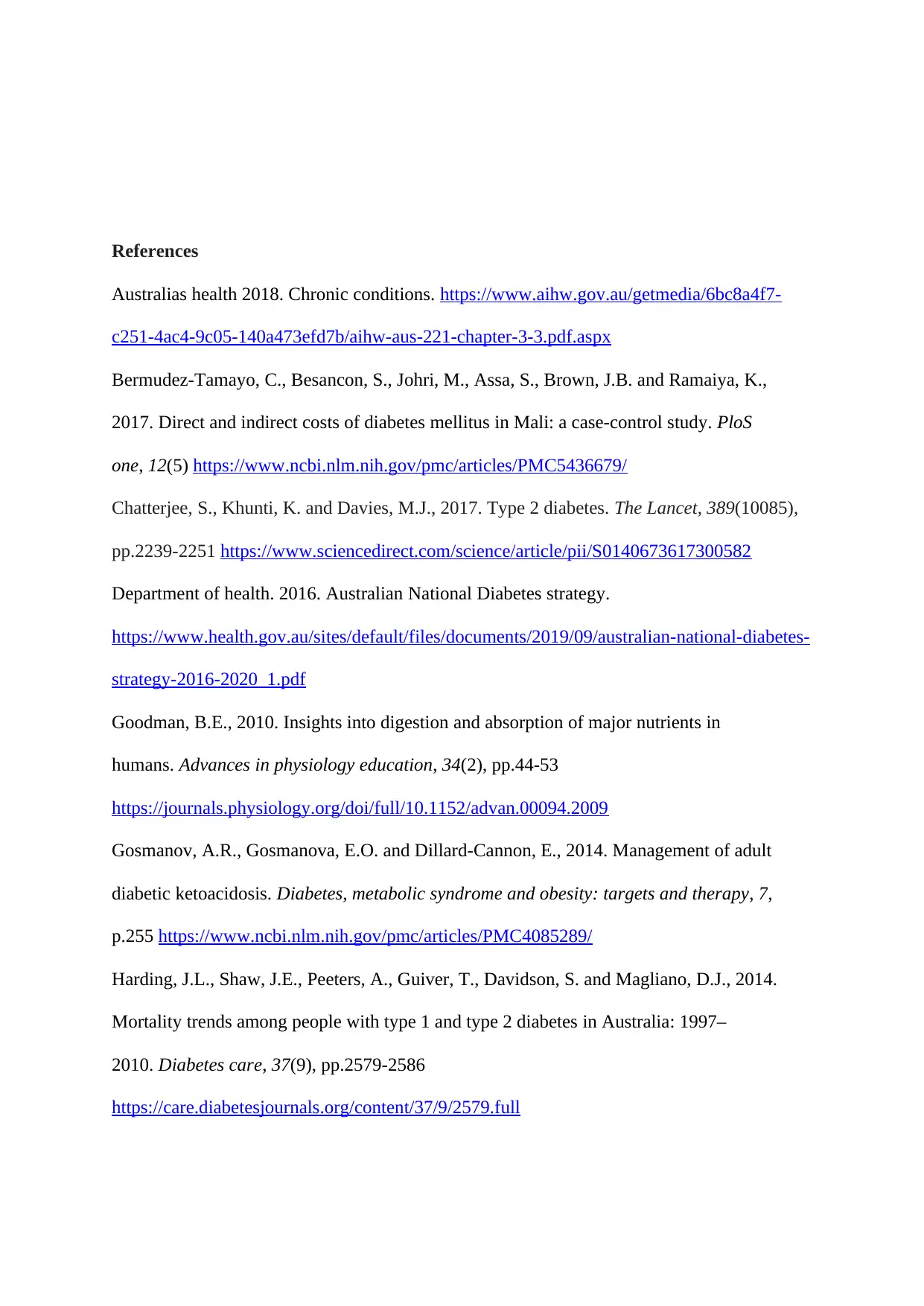
References
Australias health 2018. Chronic conditions. https://www.aihw.gov.au/getmedia/6bc8a4f7-
c251-4ac4-9c05-140a473efd7b/aihw-aus-221-chapter-3-3.pdf.aspx
Bermudez-Tamayo, C., Besancon, S., Johri, M., Assa, S., Brown, J.B. and Ramaiya, K.,
2017. Direct and indirect costs of diabetes mellitus in Mali: a case-control study. PloS
one, 12(5) https://www.ncbi.nlm.nih.gov/pmc/articles/PMC5436679/
Chatterjee, S., Khunti, K. and Davies, M.J., 2017. Type 2 diabetes. The Lancet, 389(10085),
pp.2239-2251 https://www.sciencedirect.com/science/article/pii/S0140673617300582
Department of health. 2016. Australian National Diabetes strategy.
https://www.health.gov.au/sites/default/files/documents/2019/09/australian-national-diabetes-
strategy-2016-2020_1.pdf
Goodman, B.E., 2010. Insights into digestion and absorption of major nutrients in
humans. Advances in physiology education, 34(2), pp.44-53
https://journals.physiology.org/doi/full/10.1152/advan.00094.2009
Gosmanov, A.R., Gosmanova, E.O. and Dillard-Cannon, E., 2014. Management of adult
diabetic ketoacidosis. Diabetes, metabolic syndrome and obesity: targets and therapy, 7,
p.255 https://www.ncbi.nlm.nih.gov/pmc/articles/PMC4085289/
Harding, J.L., Shaw, J.E., Peeters, A., Guiver, T., Davidson, S. and Magliano, D.J., 2014.
Mortality trends among people with type 1 and type 2 diabetes in Australia: 1997–
2010. Diabetes care, 37(9), pp.2579-2586
https://care.diabetesjournals.org/content/37/9/2579.full
Australias health 2018. Chronic conditions. https://www.aihw.gov.au/getmedia/6bc8a4f7-
c251-4ac4-9c05-140a473efd7b/aihw-aus-221-chapter-3-3.pdf.aspx
Bermudez-Tamayo, C., Besancon, S., Johri, M., Assa, S., Brown, J.B. and Ramaiya, K.,
2017. Direct and indirect costs of diabetes mellitus in Mali: a case-control study. PloS
one, 12(5) https://www.ncbi.nlm.nih.gov/pmc/articles/PMC5436679/
Chatterjee, S., Khunti, K. and Davies, M.J., 2017. Type 2 diabetes. The Lancet, 389(10085),
pp.2239-2251 https://www.sciencedirect.com/science/article/pii/S0140673617300582
Department of health. 2016. Australian National Diabetes strategy.
https://www.health.gov.au/sites/default/files/documents/2019/09/australian-national-diabetes-
strategy-2016-2020_1.pdf
Goodman, B.E., 2010. Insights into digestion and absorption of major nutrients in
humans. Advances in physiology education, 34(2), pp.44-53
https://journals.physiology.org/doi/full/10.1152/advan.00094.2009
Gosmanov, A.R., Gosmanova, E.O. and Dillard-Cannon, E., 2014. Management of adult
diabetic ketoacidosis. Diabetes, metabolic syndrome and obesity: targets and therapy, 7,
p.255 https://www.ncbi.nlm.nih.gov/pmc/articles/PMC4085289/
Harding, J.L., Shaw, J.E., Peeters, A., Guiver, T., Davidson, S. and Magliano, D.J., 2014.
Mortality trends among people with type 1 and type 2 diabetes in Australia: 1997–
2010. Diabetes care, 37(9), pp.2579-2586
https://care.diabetesjournals.org/content/37/9/2579.full
Paraphrase This Document
Need a fresh take? Get an instant paraphrase of this document with our AI Paraphraser
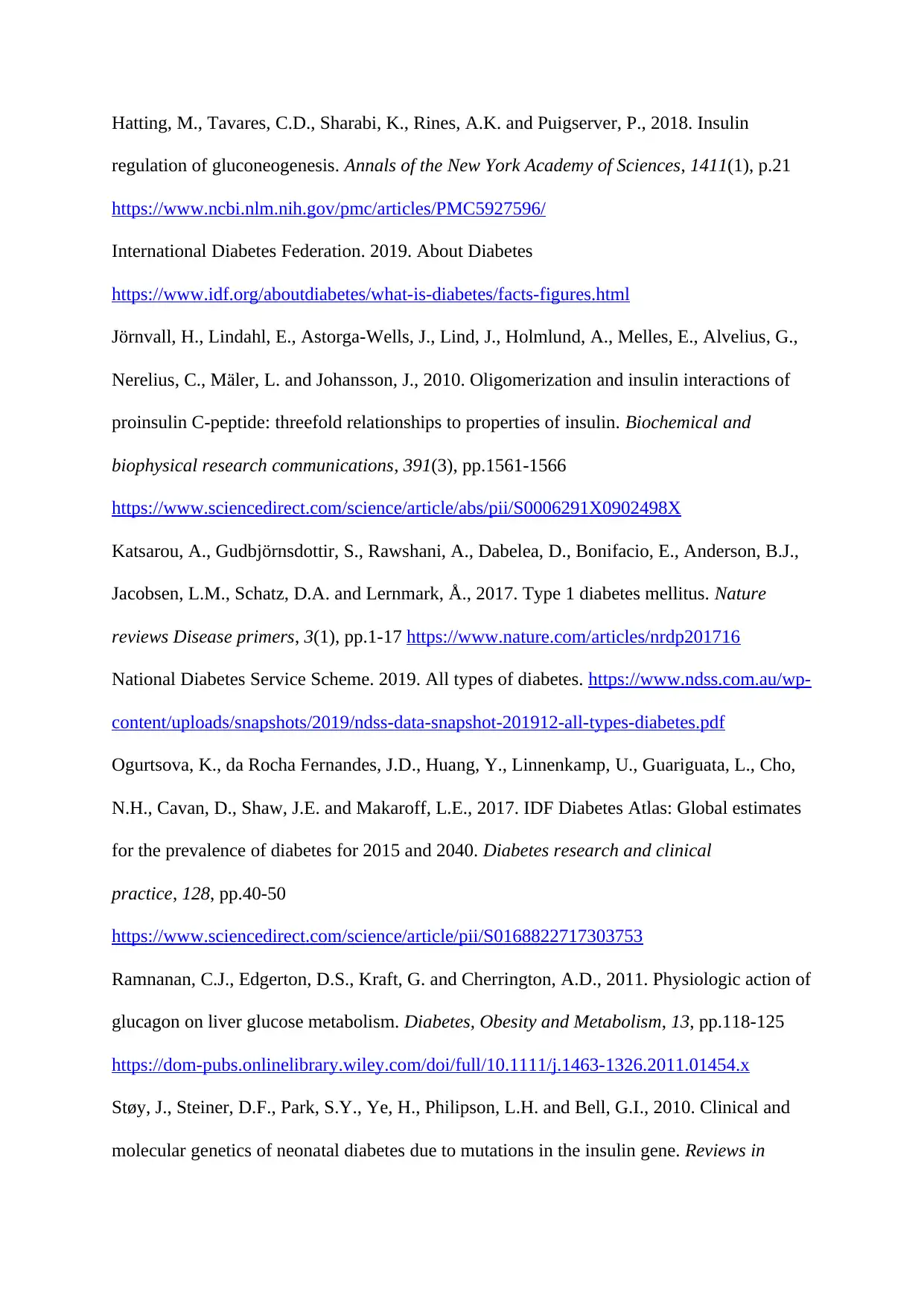
Hatting, M., Tavares, C.D., Sharabi, K., Rines, A.K. and Puigserver, P., 2018. Insulin
regulation of gluconeogenesis. Annals of the New York Academy of Sciences, 1411(1), p.21
https://www.ncbi.nlm.nih.gov/pmc/articles/PMC5927596/
International Diabetes Federation. 2019. About Diabetes
https://www.idf.org/aboutdiabetes/what-is-diabetes/facts-figures.html
Jörnvall, H., Lindahl, E., Astorga-Wells, J., Lind, J., Holmlund, A., Melles, E., Alvelius, G.,
Nerelius, C., Mäler, L. and Johansson, J., 2010. Oligomerization and insulin interactions of
proinsulin C-peptide: threefold relationships to properties of insulin. Biochemical and
biophysical research communications, 391(3), pp.1561-1566
https://www.sciencedirect.com/science/article/abs/pii/S0006291X0902498X
Katsarou, A., Gudbjörnsdottir, S., Rawshani, A., Dabelea, D., Bonifacio, E., Anderson, B.J.,
Jacobsen, L.M., Schatz, D.A. and Lernmark, Å., 2017. Type 1 diabetes mellitus. Nature
reviews Disease primers, 3(1), pp.1-17 https://www.nature.com/articles/nrdp201716
National Diabetes Service Scheme. 2019. All types of diabetes. https://www.ndss.com.au/wp-
content/uploads/snapshots/2019/ndss-data-snapshot-201912-all-types-diabetes.pdf
Ogurtsova, K., da Rocha Fernandes, J.D., Huang, Y., Linnenkamp, U., Guariguata, L., Cho,
N.H., Cavan, D., Shaw, J.E. and Makaroff, L.E., 2017. IDF Diabetes Atlas: Global estimates
for the prevalence of diabetes for 2015 and 2040. Diabetes research and clinical
practice, 128, pp.40-50
https://www.sciencedirect.com/science/article/pii/S0168822717303753
Ramnanan, C.J., Edgerton, D.S., Kraft, G. and Cherrington, A.D., 2011. Physiologic action of
glucagon on liver glucose metabolism. Diabetes, Obesity and Metabolism, 13, pp.118-125
https://dom-pubs.onlinelibrary.wiley.com/doi/full/10.1111/j.1463-1326.2011.01454.x
Støy, J., Steiner, D.F., Park, S.Y., Ye, H., Philipson, L.H. and Bell, G.I., 2010. Clinical and
molecular genetics of neonatal diabetes due to mutations in the insulin gene. Reviews in
regulation of gluconeogenesis. Annals of the New York Academy of Sciences, 1411(1), p.21
https://www.ncbi.nlm.nih.gov/pmc/articles/PMC5927596/
International Diabetes Federation. 2019. About Diabetes
https://www.idf.org/aboutdiabetes/what-is-diabetes/facts-figures.html
Jörnvall, H., Lindahl, E., Astorga-Wells, J., Lind, J., Holmlund, A., Melles, E., Alvelius, G.,
Nerelius, C., Mäler, L. and Johansson, J., 2010. Oligomerization and insulin interactions of
proinsulin C-peptide: threefold relationships to properties of insulin. Biochemical and
biophysical research communications, 391(3), pp.1561-1566
https://www.sciencedirect.com/science/article/abs/pii/S0006291X0902498X
Katsarou, A., Gudbjörnsdottir, S., Rawshani, A., Dabelea, D., Bonifacio, E., Anderson, B.J.,
Jacobsen, L.M., Schatz, D.A. and Lernmark, Å., 2017. Type 1 diabetes mellitus. Nature
reviews Disease primers, 3(1), pp.1-17 https://www.nature.com/articles/nrdp201716
National Diabetes Service Scheme. 2019. All types of diabetes. https://www.ndss.com.au/wp-
content/uploads/snapshots/2019/ndss-data-snapshot-201912-all-types-diabetes.pdf
Ogurtsova, K., da Rocha Fernandes, J.D., Huang, Y., Linnenkamp, U., Guariguata, L., Cho,
N.H., Cavan, D., Shaw, J.E. and Makaroff, L.E., 2017. IDF Diabetes Atlas: Global estimates
for the prevalence of diabetes for 2015 and 2040. Diabetes research and clinical
practice, 128, pp.40-50
https://www.sciencedirect.com/science/article/pii/S0168822717303753
Ramnanan, C.J., Edgerton, D.S., Kraft, G. and Cherrington, A.D., 2011. Physiologic action of
glucagon on liver glucose metabolism. Diabetes, Obesity and Metabolism, 13, pp.118-125
https://dom-pubs.onlinelibrary.wiley.com/doi/full/10.1111/j.1463-1326.2011.01454.x
Støy, J., Steiner, D.F., Park, S.Y., Ye, H., Philipson, L.H. and Bell, G.I., 2010. Clinical and
molecular genetics of neonatal diabetes due to mutations in the insulin gene. Reviews in
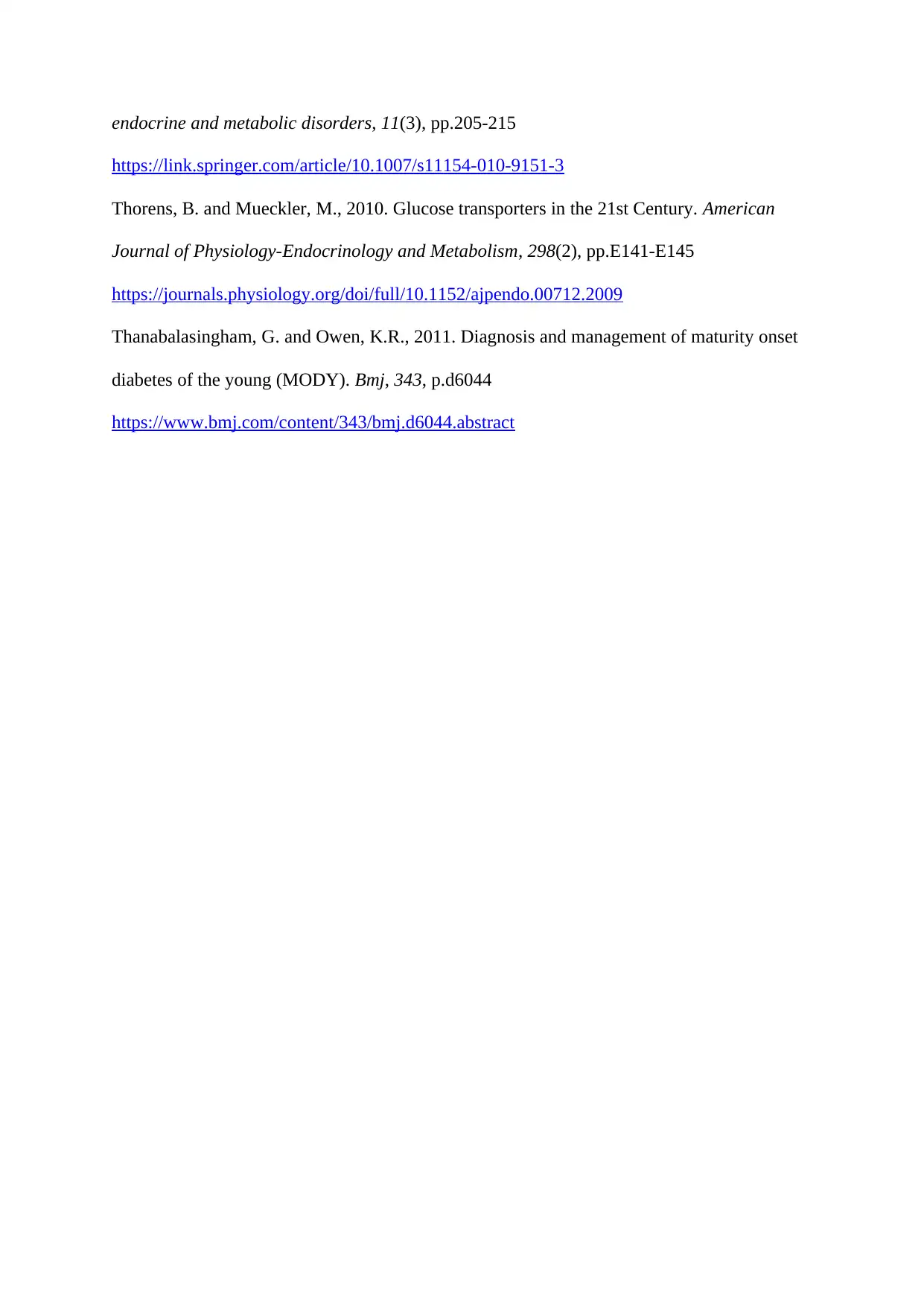
endocrine and metabolic disorders, 11(3), pp.205-215
https://link.springer.com/article/10.1007/s11154-010-9151-3
Thorens, B. and Mueckler, M., 2010. Glucose transporters in the 21st Century. American
Journal of Physiology-Endocrinology and Metabolism, 298(2), pp.E141-E145
https://journals.physiology.org/doi/full/10.1152/ajpendo.00712.2009
Thanabalasingham, G. and Owen, K.R., 2011. Diagnosis and management of maturity onset
diabetes of the young (MODY). Bmj, 343, p.d6044
https://www.bmj.com/content/343/bmj.d6044.abstract
https://link.springer.com/article/10.1007/s11154-010-9151-3
Thorens, B. and Mueckler, M., 2010. Glucose transporters in the 21st Century. American
Journal of Physiology-Endocrinology and Metabolism, 298(2), pp.E141-E145
https://journals.physiology.org/doi/full/10.1152/ajpendo.00712.2009
Thanabalasingham, G. and Owen, K.R., 2011. Diagnosis and management of maturity onset
diabetes of the young (MODY). Bmj, 343, p.d6044
https://www.bmj.com/content/343/bmj.d6044.abstract
⊘ This is a preview!⊘
Do you want full access?
Subscribe today to unlock all pages.

Trusted by 1+ million students worldwide
1 out of 9
Related Documents
Your All-in-One AI-Powered Toolkit for Academic Success.
+13062052269
info@desklib.com
Available 24*7 on WhatsApp / Email
![[object Object]](/_next/static/media/star-bottom.7253800d.svg)
Unlock your academic potential
Copyright © 2020–2025 A2Z Services. All Rights Reserved. Developed and managed by ZUCOL.





